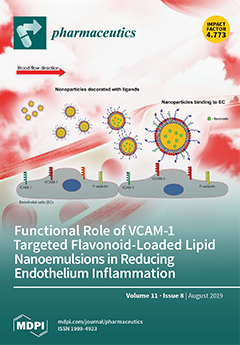Targeted radionuclide therapy with
177Lu- and
90Y-labeled radioconjugates is a clinically-established treatment modality for metastasized cancer.
47Sc is a therapeutic radionuclide that decays with a half-life of 3.35 days and emits medium-energy β
−-particles. In this study,
47Sc
[...] Read more.
Targeted radionuclide therapy with
177Lu- and
90Y-labeled radioconjugates is a clinically-established treatment modality for metastasized cancer.
47Sc is a therapeutic radionuclide that decays with a half-life of 3.35 days and emits medium-energy β
−-particles. In this study,
47Sc was investigated, in combination with a DOTA-folate conjugate, and compared to the therapeutic properties of
177Lu-folate and
90Y-folate, respectively. In vitro,
47Sc-folate demonstrated effective reduction of folate receptor-positive ovarian tumor cell viability similar to
177Lu-folate, but
90Y-folate was more potent at equal activities due to the higher energy of emitted β
−-particles. Comparable tumor growth inhibition was observed in mice that obtained the same estimated absorbed tumor dose (~21 Gy) when treated with
47Sc-folate (12.5 MBq),
177Lu-folate (10 MBq), and
90Y-folate (5 MBq), respectively. The treatment resulted in increased median survival of 39, 43, and 41 days, respectively, as compared to 26 days in untreated controls. There were no statistically significant differences among the therapeutic effects observed in treated groups. Histological assessment revealed no severe side effects two weeks after application of the radiofolates, even at double the activity used for therapy. Based on the decay properties and our results,
47Sc is likely to be comparable to
177Lu when employed for targeted radionuclide therapy. It may, therefore, have potential for clinical translation and be of particular interest in tandem with
44Sc or
43Sc as a diagnostic match, enabling the realization of radiotheragnostics in future.
Full article






